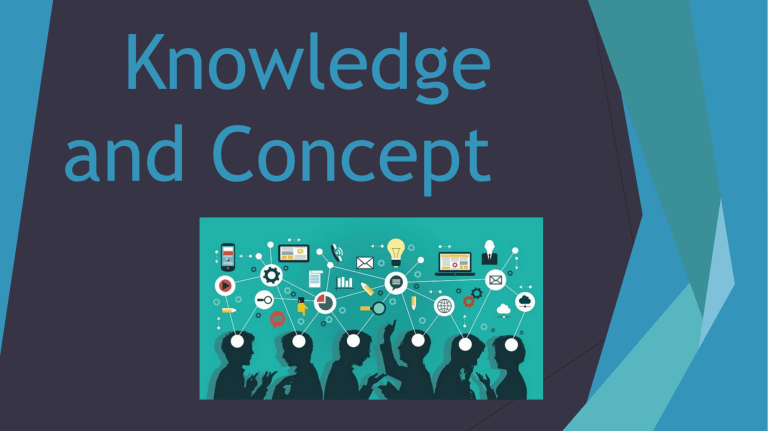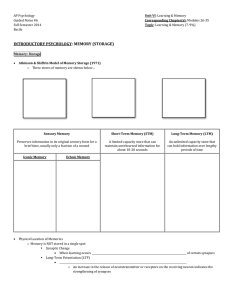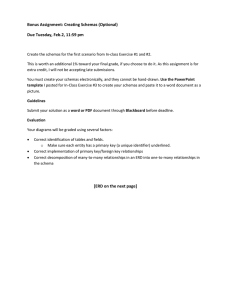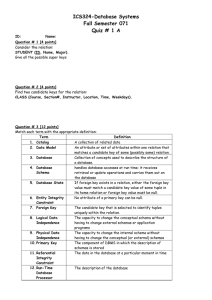
Knowledge and Concept Categorization process groups by which things are placed into Definitional Approach to Categorization we can decide whether something is a member of a category by determining whether a particular object meets the definition of the category not effective Definitional Approach to Categorization “not effective” Family Resemblance refers to the idea that things in a particular category resemble one another in a number of ways The Prototype Approach Prototype Approach Prototype : “typical member” of the category : average representation of the category Prototype Approach High prototypicality : a category member closely resembles the category prototype Low prototypicality : category member does not closely resemble a typical member of the category Family Resemblance 1. 2. 3. 4. chair sofa mirror telephone Family Resemblance 1. chair 2. sofa 3. mirror 4. telephone high family resemblance low family resemblance High Family Resemblance When an item’s characteristics have a large amount of overlap with the characteristics of many other items in a category, this means that the family resemblance of these items is high Little overlap means the family resemblance is low. Typicality Effect ability to judge highly prototypical objects more rapidly Prototypical Objects are Name First Category: mammals dog over bat Prototypical Objects are Affected More by Priming The Exemplar Approach The Exemplar Approach Examples : actual members of the category that a person has encountered in the past Dog: shih tzu, chow-chow, labrador The Exemplar Approach Objects that are like more of the exemplars are classified faster. Ex. Eagle over penguin Best approach for categorizing Exemplar approach may work best for small categories, such as “” and the prototype approach may work best for larger categories such as birds. Levels of Categories Hierarchical Organization kind of organization, in which larger, more general categories are divided into smaller, more specific categories, creating a number of levels of categories Knowledge and Organization Our ability to categorize is learned from experience; it depends on which objects we typically encounter and what characteristics of objects we pay attention to. How are concepts organized in the mind. Semantic Networks COLLINS AND QUILLIAN’S HIERARCHICAL MODEL Cognitive Economy : way of storing shared properties just once at a higher level node Spreading activation: activity that spreads out along any link that is connected to an activated node Lexical Decision Task Criticism to Hierarchical Model: Couldn’t explain typicality effect COLLINS AND LOFTUS MODEL: PERSONAL EXPERIENCE AFFECTS NETWORKS spacing between various concepts can differ for various people depending on their experience and knowledge about specific concepts. Criticism to Collins and Loftus model: Too flexible and difficult to falsify Criticism to Semantic Network Approach: if a theory can explain almost any result by adjusting various properties of the model, what has it really explained? Connectionist Approach Connectionism an approach to creating computer models for representing concepts and their properties based on characteristics of the brain Parallel Distributed Processing (PDP) Parallel Distributed Processing approach proposes that cognitive processes can be represented by a model in which activation flows through networks that link together a large number of simple, neuron-like units Distributed: activations occur in several different locations Parallel: activations take place simultaneously Task: Characteristics of PDP 1. Cognitive processes are based on parallel operations, rather than serial operations. Many patterns of activation may be proceeding simultaneously. Characteristics of PDP 2. Network contains basic neuron-like units or nodes, which are connected together so that a specific node has many links to other nodes Cognitive processes can be explained by the activation of these networks. Characteristics of PDP 3. Concept is represented by the pattern of activity distributed throughout a set of nodes. Characteristics of PDP 4. Current context often activates only certain components of a concept’s meaning. Information can be stored in a network form PDP can help people make spontaneous generalization. Spontaneous generalization: using individual cases to draw inferences about “engineers as not good with language” Spontaneous generalization can lead to memory errors and stereotyping. PDP can help people make default assignment. Default assignment: filling in missing information about a particular person or a particular object by making a best guess based on information from other similar people or objects Spontaneous generalization : we draw a conclusion about a general category (ex. Psychology students) Default assignment: we draw a conclusion about a specific member of a category (ex. a particular psychology student) 4 Theoretical Features of PDP 1. The connections between these neuronlike units are weighted, and these connection weights determine how much activation one unit can pass on to another unit. As you learn more information, the values of these weights will change. 4 Theoretical Features of PDP 2. When a unit reaches a critical level of activation, it may affect another unit, either by exciting it (if the connection weight is positive) or by inhibiting (if the connection weight is negative). Ex. The characteristic polite might have a negative connection weight associated with some of the less civilized students 4 Theoretical Features of PDP 3. Each new experience with a particular item will change the strength of connections among relevant units by adjusting the connection weights. 4 Theoretical Features of PDP 4. Sometimes we have only partial memory for some information, rather than complete, perfect memory. The brain’s ability to provide partial memory is called graceful degradation Ex. Tip-of-the-tongue phenomenon Schemas and Scripts Schema generalized, well-integrated knowledge about a situation, an event, or a person Schema theories: Our memories encode ‘‘generic’’ information about a situation. Then we use this information to understand and remember new examples of the schema Script simple, well-structured sequence of events in a specified order; this script is associated with a highly familiar activity Life Script a list of events that a person believes would be most important throughout his or her lifetime Task: Identify seven most important events Life Script A violation of life script is devastating Operation of Schemas & Scripts in Cognitive Processing 1.During the selection of material to be remembered. 2. In boundary extension (when your memory stores a scene). 3. During memory abstraction (when your memory stores the meaning, but not the specific details of the material). 4. During memory integration (when your memory forms a wellintegrated representation of the material). 1. Schemas and Memory Selection What items can you remember from the photo? 1. Schemas and Memory Selection people were highly likely to recall objects consistent with the ‘‘office schema.’’ people may not have time to process schema-irrelevant items (ie. Wine bottle & picnic basket) 1. Schemas and Memory Selection Reconstruction error: schema-consistent error the tendency to supply schema consistent items 1. Schemas and Memory Selection People sometimes show better recall for material that violates our expectations People are more likely to recall schemainconsistent material when that material is especially vivid and surprising 2. Schemas and Boundary Extension 2. Schemas and Boundary Extension refers to our tendency to remember having viewed a greater portion of a scene than was actually shown Our cognitive processes fill in the incomplete objects 2. Schemas and Boundary Extension Eyewitness testimony Eyewitnesses may recall having seen some features of a suspect’s face, even though these features were not actually visible at the scene of the crime Looking for a person in a crowd 3. Schemas and Memory Abstraction Abstraction is a memory process that stores the meaning of a message, rather than the exact words Constructive Approach Pragmatic Approach 3. Schemas and Memory Abstraction Constructive Approach False alarm occurs when people ‘‘remember’’ an item that was not originally presented People were especially likely to make false alarms when a complex sentence was consistent with the original schema. 3. Schemas and Memory Abstraction Constructive Approach False alarm People seldom made false alarms for sentences that violated the meaning of the earlier sentences. 3. Schemas and Memory Abstraction Example ‘‘The tall tree in the front yard shaded the man who was smoking his pipe.’’ vs ‘‘The scared cat that broke the window on the porch climbed the tree.’’ 3. Schemas and Memory Abstraction Constructive Approach People integrate information from individual sentences in order to construct larger ideas. We typically store an abstract of the information, rather than a word-for-word representation. 3. Schemas and Memory Abstraction Pragmatic Approach proposes that people pay attention to the aspect of a message that is most relevant to their current goals 3. Schemas and Memory Abstraction Pragmatic Approach 1. People know that they usually need to accurately recall the gist of a sentence. 2. They also know that they usually do not need to remember the specific wording of the sentences. 3. However, in those cases where they do need to pay attention to the specific wording, then they know that their verbatim memory needs to be highly accurate. 3. Schemas and Memory Abstraction Pragmatic Approach People are particularly likely to pay attention to the exact wording of a sentence if the words are part of a criticism or an insult. We are especially sensitive about emotionally threatening material, so we make an effort to recall the exact words of the sentences. 4. Memory Integration Our background knowledge encourages us to take in new information in a schemaconsistent fashion. Individual’s unique interests and personal background often shape the contents of memory Memory Integration and Gender Stereotypes Study 1: Original sentence: “The women at the office liked to talk around the water cooler.’’ ‘‘The women at the office liked to gossip around the water cooler.’’ (29% says they’ve seen the sentence before) ‘‘The women at the office liked to talk sports around the water cooler.’’ (18% says they’ve seen the sentence before) Memory Integration and Gender Stereotypes Study 2: ‘‘The nurse prepared himself for the operation.” the unexpected, stereotype-inconsistent word himself produced changes in the ERPs (event-related potential technique) Memory Integration and Gender Stereotypes Stereotypes can have the power to influence people’s self-images and their sense of academic competence.


